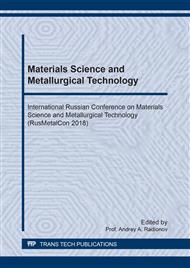[1]
V.N. Ivanov, Dictionary and Handbook of Foundry Production. Moscow, Mashinostroyenie. (1990).
Google Scholar
[2]
I.D.m Kashcheyev, K.K. Strelov, P.S. Mamykin, Chemical Technology of Refractories, Moscow: Internet Engineering, (2007).
Google Scholar
[3]
K.K. Strelov, Theoretical Fundamentals of Refractory Materials Technology, Moscow: Metallurgiya, (1996).
Google Scholar
[4]
Ya.I. Shklennik, V.A. Ozerov, Investment Casting: a monograph, Мoscow: Mashinostroyeniye, (1984).
Google Scholar
[5]
R.K. Mysik, S.V. Brusnitsyn, A.V. Sulitsin, S.P. Pavlinich, S.V. Bakerin, B.A. Kulakov, Inestigation of operational characteristics of special-purpose alloy catings, Russian Journal of Non-Ferrous Metals, 58(3) (2017) 231-237.
DOI: 10.3103/s1067821217030142
Google Scholar
[6]
V.S. Balkevich, Technological Ceramics, Moscow. Stroyzdat, (1984).
Google Scholar
[7]
Yu.A. Krasulin, Porous Structural Ceramics. – Moscow. Metallurgiya, (1980).
Google Scholar
[8]
D.P.H. Hasselman, Griffiths Flaaws and the Effect Rarosity on TensileStrength of Brittle Ceramise, J. Amer. Ceram. Soc. 52(8) (1969).
Google Scholar
[9]
D.P.H. Hasselman, Unified theory of thermal shock fracture initiation and crack propagation in brittle ceramics. J. Amer. Ceram. Soc. 52(11) (1962) 600-604.
DOI: 10.1111/j.1151-2916.1969.tb15848.x
Google Scholar
[10]
W.D. Kingery, Introduction to Ceramics: Translated from English. Moscow: Stroyizdat, (1967).
Google Scholar
[11]
W.D. Kingery, Property Measurements at High Temperatures. Moscow: Metallurgizdat, (1963).
Google Scholar
[12]
L.S. Leibenson, Movement of Natural Fluids in Porous Media. Moscow, Leningrad. Gostekhizdat, (1947).
Google Scholar
[13]
D.P.H. Hasselman, Griffith criteroin and thermal shock resistant of single-Phase versus multiphase brittle ceramies, J. Amer. Ceram. Soc. 52(5) (1969) 188-289.
DOI: 10.1111/j.1151-2916.1969.tb09188.x
Google Scholar
[14]
D.P.H. Hasselman, Elastic energy at frakture at surface energy as design criteria for thermal shock. J. Amer. Ceram. Soc. 46(11) (1963) 535–40.
Google Scholar
[15]
D.P.H. Hasselman, Figures of merit for the thermal stress resistance of high-temperature brittle materials: a rewiew. Ceramurgia International. 4(4) (1978) 147-150.
DOI: 10.1016/0390-5519(78)90028-5
Google Scholar
[16]
J. Nakayama, Thermal shock resistance of ceramic materials. In: Fracture mechanics of ceramics, plenum press, New Jork - London. 2 (1973) 759-778.
DOI: 10.1007/978-1-4615-7014-1_20
Google Scholar
[17]
K. Chyng, Fracture energy and thermal shock resistance of mica glass-ceramics. In: Fracture mechanics of ceramics, plenum press / New Jork London. 2 (1973) 495-508.
DOI: 10.1007/978-1-4615-7014-1_4
Google Scholar
[18]
Chyung Kenneth, Fracture energy and thermal shock resistance of mica glass ceramics. Fracture Mech. Ceram. New York - London. 2 (1974) 495-508.
DOI: 10.1007/978-1-4615-7014-1_4
Google Scholar
[19]
E. Glenny, M.G. Royston, Transcient thermal stresses promoted by the rapid heating and cooling of brittle circular cylinders. Trans. Brit. Cer. Soc. 10 (1958) 645-677.
Google Scholar
[20]
V.N. Karnozhitsky, Contact Heat Transfer in Casting: Kyiv: Nauk. Dumka, (1978).
Google Scholar


